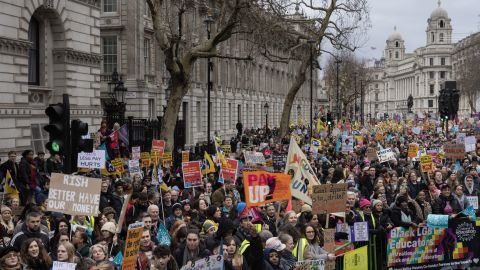By Hanna Ziady, CNN
Tue February 14, 2023

Education workers rally in Westminster, London during a day of strikes across the United Kingdom on February 1, 2023.Dan Kitwood/Getty Images
LondonCNN —
The United Kingdom lost more working days to strikes in 2022 than in any year since 1989, as employees walked out in large numbers over pay amid soaring living costs.
Figures from the Office for National Statistics (ONS) showed Tuesday that nearly 2.5 million working days were lost to industrial action between June and December, the highest since 1989 when 4.1 million days were lost.
The ONS said 843,000 working days were lost in December 2022 alone — the highest monthly number since November 2011.
Workers in health care, communications and transportation were among those who walked out in the run-up to Christmas. The Royal College of Nursing, which represents nearly 500,000 nurses, midwives and health care assistants, staged its first ever strike in December.

Britain hit by biggest day of strikes in a decade as pay disputes escalate
Strike action has dragged into the new year, disrupting schools and public transport. As many as half a million workers, including teachers, staged the biggest single day of walkouts in more than a decade on February 1.
Workers are demanding higher wages as they grapple with a cost-of-living crisis, with inflation near its highest level in four decades. Many public sector workers have been offered raises of 4% or 5% for the current financial year, far lower than the 10.5% annual inflation rate in December. The ONS will publish inflation figures for January on Wednesday.
Real pay falls
The UK government has so far refused to grant public sector workers higher pay awards, arguing that doing so risks making the inflation problem worse. The government is instead introducing laws that will make it harder for key workers to strike.
The ONS said Tuesday that after taking inflation into account, growth in average regular pay, which excludes bonuses, fell by 2.5% between October and December 2022 compared with the same period in 2021. That’s among the largest drops since records began in 2001.
For public sector workers, the decline in real pay will have been worse as, without adjusting for inflation, their wages grew a lot less compared with private sector earnings. Average regular pay growth for the public sector was 4.2% in the final three months of last year compared with the same period in 2021, versus growth of 7.3% for the private sector.
The ONS said private sector pay growth was at its strongest outside the height of the coronavirus pandemic.
“Although there is still a large gap between earnings growth in the public and private sectors, this narrowed slightly in the latest period,” ONS director of economic statistics Darren Morgan said in a statement. “Overall, pay, though, continues to be outstripped by rising prices.”
A separate survey published Monday by the Chartered Institute of Personnel Development (CIPD) found that UK employers expect to give employees a median pay rise of 5% this year, the highest increase in 11 years.
“However, median anticipated public sector pay rise expectations of 2% lag those in the private sector at 5%, with the gap providing the context for ongoing discontent and strikes among key public sector workers,” the CIPD said.
No comments:
Post a Comment